- Offensive Techniques & Strategies
Creating Leads
"Getting open before you receive the ball."
Here's What to Expect:
Discover the importance of creating good leads to offensive success.
Learn that communication and precise timing between passer and receiver are vital.
Learn about Tex Winter's "Line of Action."
Realize the importance of meeting all passes.
Explore five proven techniques to get open.
Find out how to use teamwork and "Off-Ball" Screens to get open.
Skills & Techniques to Get Open
| Timing | Basic Rule | Back Cuts | 5 Proven Techniques | Teamwork |
Learning how to get open is a vital, but often overlooked, component of a success offensive attack. All the individual moves and skills in the world are useless when a receiver receives the ball out of position. Therefore, with today's pressure defenses, it is important for receivers to possess the abilities and skills to get open while maintaining proper court spacing. In creating leads, individual effort and techniques can be supplement with teamwork by setting various types of off-ball screens for receiver.
Timing

As a receiver, it is important to receive the basketball in a triple threat position on a spot on the court where you can effectively shoot, drive or pass. This requires a coordinated effort and precise timing on the part of both the receiver and passer. The receiver must first wait until the passer is in a position to make the pass, establish eye contact, and present a good target.
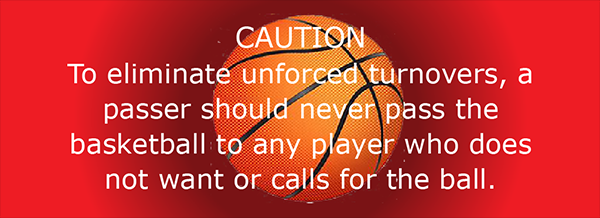
Line of Action Rule
Timing is critical. If the receiver creates a lead too early or too late, it will be of no value. In order to achieve the proper timing between passer and receiver, when the ballhandler puts their off hand on ball, it initiates or "triggers" the action on the part of the receivers. Once a move to get open is initiated, it should take only a couple of seconds to create the separation from the defender. Any longer than that will allow time for the defender to recover and will also force the passer into look for another receiver.
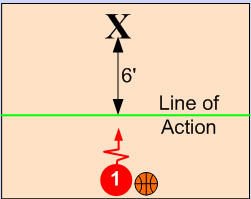
Basketball coaching legend, Tex Winter, coined the term “Line or moment of Truth” to indicate an imaginary line three feet in front of the ballhandler’s defensive player. When the dribbler reaches this line, they must be under control and able to pass to any of the four potential receivers. The receivers also key off this line of action to initiate their moves to get open.
Must Meet All Passes!
The importance of meeting the pass cannot be over-emphasized. It is the receiver's responsibility to seal off the defender, maintain a position between the passer, and step out to meet the pass. "When the ball is in the air, the feet are in the air."In meeting the pass, it prevents the defender from stepping around and deflecting or intercepting the pass. However, in meeting the pass, it is important as the receiver to maintain proper court spacing.
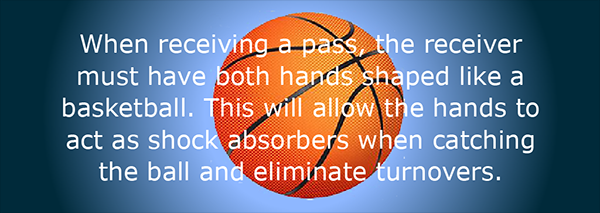
>Catch the ball in the air with eyes and two hands landing in a jump stop with the inside shoulder facing the passer. This footwork allows the receiver to pivot on either foot, see all the players on the court, and execute a quick reverse pivot (drop step) and drive to the basket if the defender should overplay the passing lane. In addition, by pivoting on the inside foot to face up to the basket, it puts the receiver closer to the basket.
Against zone defenses the receiver should receive the ball facing the basket.
The Importance of Keeping Your Hands Up - Learn More Click Here
Back Cuts
Back cuts play an important role against pressure defense that incorporate strong pass denials. Don't fight pressure. If overplayed back cut hard to the basket. In making a back cut, the receiver must make eye contact with the passer.
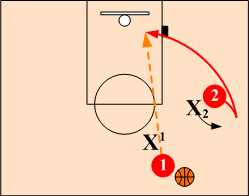
The key to a back cut is to break all the way to the basket.
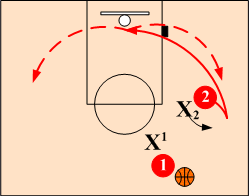
Once at the basket, if the receiver does not receive the ball, they have the options of continuing out to the weakside, breaking back out same side, or curling up the middle.
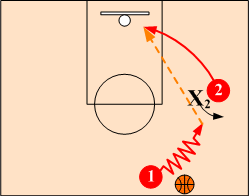
When an entry pass to a wing is strongly overplayed, the ballhandler can make a dribble entry by dribbling toward the receiver. The receiver seeing the ballhander's dribble penetration, back cuts to the basket looking for a feed.
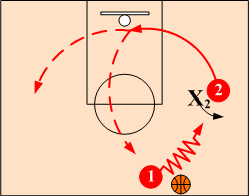
If the receiver does not receive a pass, they continue out to the weakside or curl up the middle. By eliminating the entry pass and dribbling to the wing to initiate offense, it cuts down on the number of turnovers.
Getting Open
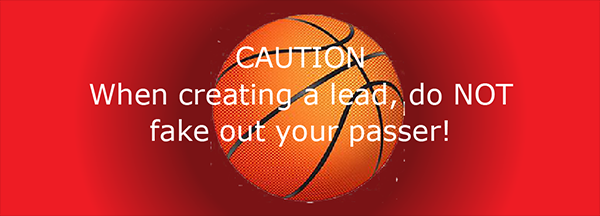
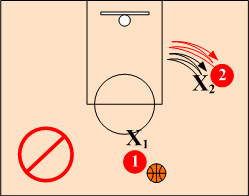
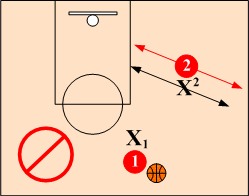
Trying to get open by “Head Bobbing” or taking a few steps back and forth or in the same direction in an effort to get open will result in faking out the passer more times than the defender.

Five Proven Ways to Get Open
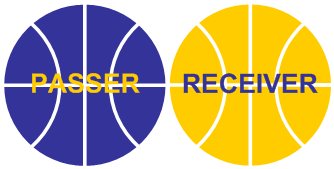
A change of pace is more effective in getting open than relying on quickness. In most cases, the receiver should start in either a stationary low, bent knee position to freeze the defender or slowly walk the defender prior to accelerating and making a quick move to get open.
General Rule
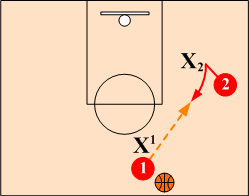
If the defender plays low: Take low and break high.
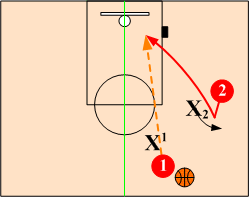
If the defender plays high: Take high and break low (back cut).
1. "V-Cut" Technique
The V-cut is the most common technique to get open.
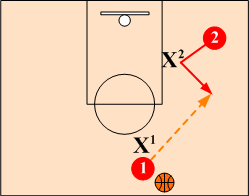
Starting out in a short corner position, the receiver takes one or two steps into the defender initiating contact by bumping them with their inside shoulder (arm held tight to body). This bump temporarily will freeze the defender allowing the receiver to step out with a target hand extended to receive a pass.
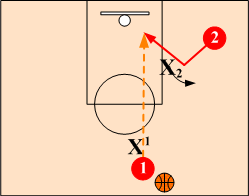
If the defender tries to recover and deny the passing lane, the receiver can back cut to the basket for shot.
2. "L-Cut" Technique
The L-cut technique is similar to the V-Cut with the receiver starting out along the free throw lane line.
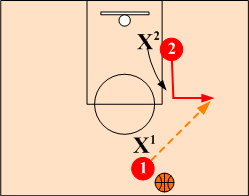
Starting out in a low post position, the receiver first steps up toward the "elbow," and then breaks sharply out to receive the pass.
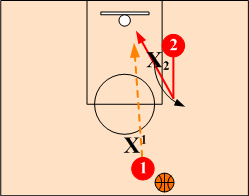
If over-played, the receiver back cuts to the basket.
3. "Step-Over" Technique
The Step-Over or "Swim" move is basically the same technique used in offensive rebounding.
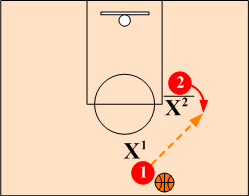
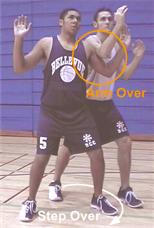
The arm over/step over offensive rebound move can be used to get open, when a defender is fronting or playing a very high 3/4 denial. By extending an arm over the defender's and bring it down, it allows the receiver to step around the defender and receive the ball.
Offensive Rebounding Techniques - Learn More Click Here
4. Post Up Technique
The same moves used in the low post area can be used anywhere on the court.
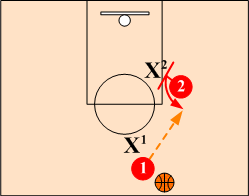
Starting out near the "Elbow" or on the wing, the receiver posts up the defender and extending the hand farthest from the defender as a target. By posting up, it allows a stronger and slower player to create a good lead against a quicker and more agile defender.
5. Teamwork - Off Ball Screens
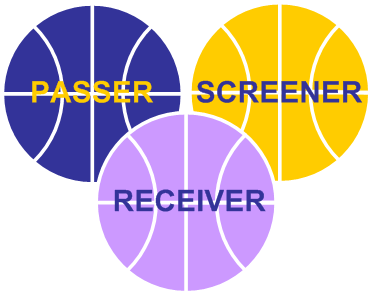
In addition to individual player effort to get open, team work can be used in getting open by executing various types of off ball screens. Off Ball screens require an unselfish attitude in setting good screens to free up teammates. To be successful, Off-Ball screens involve a coordinated effort by the screener, receiver, and passer.
Executing Off-Ball Screens Fundamentals - Learn More Click Here
Executing Off-Ball Screens Reads & Counters - Learn More Click Here
Return to Player Development - Click Here
Return to Defensive Strategies - Click Here
Return to HoopTactics - Click Here
© 2026 HoopTactics All Rights Reserved.
